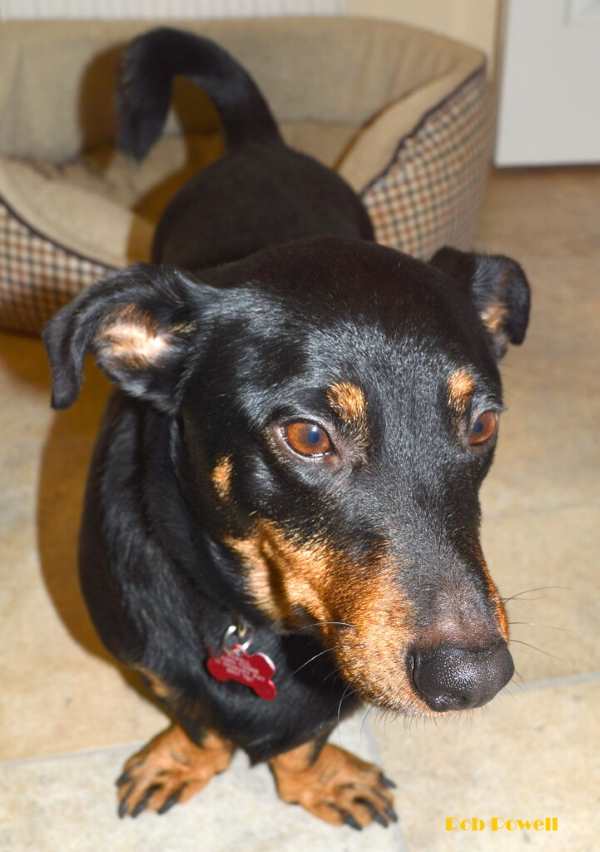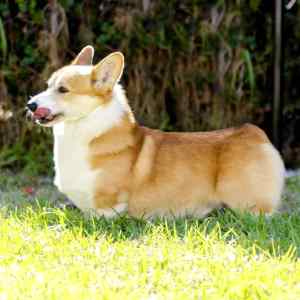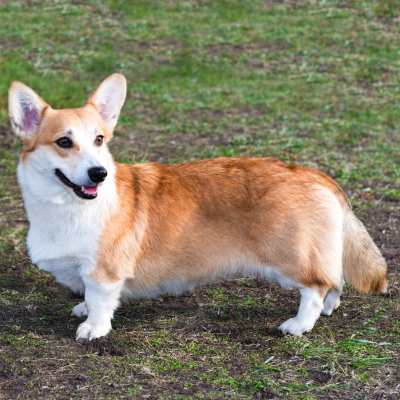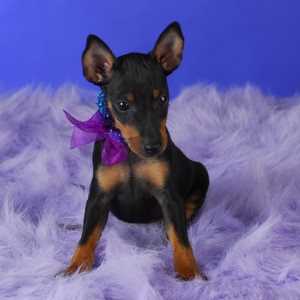- Small Dog Place Home
- A-Z Breeds A to M
- Lancashire Heeler
Lancashire Heeler
By Janice Jones |Updated 11-15-2023
Looking for a versatile dog that is equally good herding cattle as catching rats? A smart dog that is as confident in the show ring as he is keeping you company?
Well, the Lancashire Heeler may be the breed for you. He’s an energetic dog with a great work ethic and doesn’t seem to be worried that the cattle he’s herding are triple his size.
If you are in the U.S., you may not have had too much contact with this breed, and they were even put on the Endangered Breeds list in the U.K., his original home because of their dwindling numbers that put the gene pool at risk of inbreeding leading to increase of inherited diseases.
Quick Facts
Other Names Used: Ormskirk Heeler, Lancashire Terrier, Ormskirk Terrier
Affiliation: UKC: Herding, KC: Pastoral, AKC: FSS: Herding, FCI: Herding
Size
Height: 10-12 inches
Weight: 9-17 pounds
Coat Type: Double Coat, hard sleek weather resistant topcoat and soft undercoat
Colors: Black & Tan or Liver & Tan
Country of Origin: Great Britain
Activity Level: Moderate-High; this breed requires daily walks and exercise
Good with Children: Yes, older Children
Good with Other Pets: Yes, Dogs and Cats but should not be trusted with small pocket size pets
Life Expectancy: 12 - 15 years
| Traits | Rating |
|---|---|
| Playfulness | |
| Affection Level | |
| Friendliness Towards Strangers | |
| Good with Children | |
| Good with Other Dogs | |
| Good for First Time Owners | |
| Exercise Needed | |
| Ease of Training | |
| Watch Dog Ability | |
| Grooming Requirements | |
| Shedding | |
| Cold Tolerant | |
| Heat Tolerant |
Dog Breed Ratings Got You a Little Confused?
Here's a little help in understanding them
- Playfulness: Most Playful = 5 Least Playful = 1
- Affection: Most Affectionate = 5 Least Affectionate = 1
- Friendliness Towards Strangers: Most Friendly = 5 Least = 1
- Good With Children: Great= 5 Not Good with Children = 1
- Good With Dogs: Great = 5 Not Good Around Dogs = 1
- Good With First Time Owners: Fine=5 Not Appropriate = 1
- Exercise Required: Extensive Daily Exercise = 1 Minimal = 1
- Ease of Training: Very Easy = 5 Difficult = 1
- Watch Dog: Excellent Watchdog = 5 Minimal = 1
- Grooming: Time Consuming = 5 Minimal = 1
- Shedding: Heavy Shedder = 5 Minimal = 1
- Cold Tolerance: Well Tolerated = 5 Poor Tolerance = 1
- Heat Tolerance: Well Tolerated = 5 Poor Tolerance = 1
History of the Lancashire Heeler Breed
We do not know the exact beginning of this breed, but, likely, it extends back as early as 17th century Wales and England.
Historians believe that the original ancestors of the breed included Welsh Corgi and some form of the Black and Tan Terriers, most likely the Manchester Terriers.
They got their herding ability from the Corgis (Pembroke Welsh Corgi and Cardigan Welsh Corgi). Some experts think there may have been some Daschund in the mix.
They served as farm dogs and were used for cattle herding and to remove vermin (rats) from the farm. They were used to drive cattle to market and to hunt rabbits.
Even though they were small compared to the cows, they accomplished their work by nipping at their heels and then moving quickly to avoid getting kicked.
They gained popularity because of their work ethic but also because they were friendly, small, and made great companions and ideal family dogs.
After a while, though, their popularity declined, but new interest in the breed emerged in the 1960s in Britain. The Lancashire Heeler Club was formed in 1978 in Britain due in part to Gwen Macintosh, a dedicated Lancashire Heeler breeder.
The Kennel Club (KC) recognized the breed in 1981, and later the United Kennel Club (UKC) did the same in 2009. Still, the breed has been identified as a vulnerable native breed in England since 2003.
As of this writing, the American Kennel Club recognizes them in their Foundation Stock Services and placed the breed in its Miscellaneous Class. The FCI accepted the breed in 2016 on a provisional basis.
These dogs are also a favorite in Sweden, the Netherlands and in Australia.
Personality
Stubborn, mischievous, and highly intelligent are ways to describe these dogs that are more considered companion dogs today than ratters or herders.
Lancashire heelers make great family dogs because they are affectionate and versatile, adapting to a wide variety of home settings. This breed does well with older children because he is playful and loves to run and chase. The Lancaster Heeler may not be the right choice for families with young children. His strength and activity level may be too much for young children.
These dogs also have a tendency to nip at people’s heels the way they might when herding cattle, especially young children. Training them not to nip people when they are puppies is vital to prevent later problems.
Socialization at an early age is essential and should comprise plenty of interactions among children and other pets. They are fine around other dogs and cats as long as they have been socialized with them but may have problems if a second dog is introduced into the family especially if the first has little experience with living with other pets.
Since they have those terrier instincts, smaller pets should be kept at a safe distance as the Lancashire Heeler may mistake them for prey.
This breed is known for its intelligence, so they learn quickly. With that said, a potential new owner should know they have a streak of stubbornness and a mind of their own. Thus, training may not always go as planned.
The best owners will be kind but firm and understand that consistency with positive reinforcement will prove to be the best training methods.
Health Concerns
The Lancashire Heeler is a healthy breed but does have some inherited diseases. Three eye conditions are common, including Primary Lens Luxation (PLL), Collie Eye Anomaly (CEA), and persistent pupillary membrane.
Primary Lens Luxation (PLL) is on the downswing because of conscientious breeding decisions by dedicated breeders. Tests for Primary Lens Luxation and Collie Eye Anomaly (CEA) are available and should be done on the adult breeding stock before using them for mating.
These dogs may also show some musculoskeletal problems common to almost all small breed dogs such as Patellar Luxation.
Primary Lens Luxation (PLL)
PLL is an inherited disorder seen in many small breed terrier dogs and is present in some Welsh Corgis.
According to the OFA (Orthopedic Foundation for Animals)
“The lens of the eye normally lies immediately behind the iris and the pupil, and is suspended in place by a series of fibers, called zonular ligaments. It functions to focus light rays on the retina, in the back of the eye. When partial or complete breakdown of the zonular ligaments occurs, the lens may become partially dislocated (Lens Subluxation) or fully dislocated (Lens Luxation) from the lens’ normal position.”
This problem can lead to glaucoma, inflammation, and painful red, teary eyes. There is a DNA test available that can be done on breeding dogs.
Collie Eye Anomaly (CEA)
This is an inherited development disease that affects collies, shelties, other types of sheepdogs, and the Lancashire Heeler.
It is caused by a mutation on the gene that determines the development of the eye, which causes the blood vessels that support the retina to be underdeveloped.
It can lead to blindness, but most dogs will adapt to their loss of vision though you may need to make some adaptation to help them live comfortably.
Persistent Pupillary Membrane
This is a congenital condition where fetal tissue remains on the eye after birth, and appears as tiny strands across the pupil and running from one side of the iris to the other side.
In healthy mammal development, the pupillary membrane comprises blood vessels that supply nutrients to the developing lens of the eye before birth. These strands are gone by 4 or 5 weeks of age, but if they persist, they can interfere with vision.
Other small breed dogs that are affected include the Welsh Corgi and Basenji. Breeders can have their dog’s eyes checked before being used for breeding and should not use dogs affected by this condition.
Grooming
If you hate to groom, this could be the perfect breed for you. They have a hard, flat coat outer coat that is similar to a terrier’s fur, dense and waterproof.
Their fine undercoat is softer and short. The hair that grows around their neck is longer than the rest of their body. They are moderate shedders and will molt their fur twice a year. They lose some of the undercoat so more brushing during these seasonal shedding periods will help keep hair off the floor and furniture.
The occasional bath every couple of months and a brushing now and again will keep them looking their best. Naturally, if your dog loves mud or enjoys rolling in smelly grass, you will want to bathe him more frequently.
A stiff bristle brush works best on this breed. Beyond this coat care, ears should be checked periodically and cleaned of excess wax and debris, and his nails will need to be clipped or ground down with a Dremel type tool.
Proper dental care is essential to all dogs, so teeth should be brushed regularly, and dental treats can be given to help keep tarter down and promote fresh breath.
Care
Best Suited For
The best owners for this breed are active families with older children, active couples, active singles and those that have had previous experience raising and training a dog.
They do fine in apartments as long as they get enough exercise and mental stimulation. They will thrive in a single-family home with a securely fenced in yard. Without fencing, these dogs should remain on a leash when outdoors.
Energy and Activity Level
This dog will not be happy as a couch potato, but in addition to physical exercise, he will also enjoy mental stimulation. Long walks, vigorous play sessions in the backyard, or a fun game of fetch will keep your dog happy.
A minimum of a 30-minute walk daily is a must, but they also enjoy runs and other active pursuits. Several walks per day are recommended.
They are very versatile dogs and will respond eagerly to accompanying you on hiking and camping trips, swimming or just learning new tricks.
They do well in dog sports such as agility, obedience, herding, and rally. If you live in an apartment, your Lancashire Heeler can still receive enough exercise by several long daily walks and fun games indoors.
If you live in a home, with a yard, we recommend that it be fenced but if not, use a leash when you are outdoors. You never know when your dog might spot a rabbit or squirrel that may not enjoy being chased. They are also great escape artists, so inspect your fence regularly for signs of an opening.
Training
Lancashire Heelers are quick to learn and highly intelligent. They like to please, but they also have a mind of their own so patience and kind firmness will go a long way.
Positive training methods are always far superior to those punitive methods used years ago. Not only are harmful methods ineffective, but they are cruel and can cause lasting damage to the bond you create with your dog.
You will also need to train your dog to avoid nipping at people's feet and ankles. You can teach your dog to stop nipping with the use of a favorite toy.
Hold the toy in your hand. When he tries to bite, wave the toy to distract him. Once he has stopped nipping and is showing interest in the toy, give it to him as a reward. You will need to repeat this game until he finally "gets it."
Feeding
The Lancashire Heeler needs a high-quality diet appropriate for his stage in life, and since he is a small breed, a small-sized kibble suitable for small dogs is recommended.
If you use a homemade or raw diet, we recommend that you first consult your veterinarian for the proper vitamins and minerals ratios. These dogs can become obese if they are fed too much and not given a job to do or sufficient exercise to burn up all those excess calories.
You can avoid this by keeping an eye on your dog’s caloric intake and the amount of exercise he gets. Fresh cold water should always be available.
As a general guideline, the Lancashire Heeler will eat about one to one-and-a-half cups of quality dry kibble per day.
Healthy snacks can be provided in moderation and most dogs love veggies and fruits.
Sometimes supplements are required to address specific health issues and a daily multi-vitamin, mineral, antioxidant supplement can't hurt.
Pros and Cons
Pros
- Good Family Dogs
- Good with older children
- Intelligent and loyal
- Friendly
- Healthy
- Little Grooming Required
Cons
- Can be escape artists
- May bark if not taught properly
- May nip at people’s feet and heels if not taught otherwise
- Needs plenty of exercises and mental stimulation
- Considered a rare breed so may be challenging to locate one
References
Canine Inherited Disorders Database
The United States Lancashire Heeler Club
Related Breeds
About Janice (author and voice behind this site)
Having lived with dogs and cats most of her life, Janice served as a veterinary technician for ten years in Maryland and twelve years as a Shih Tzu dog breeder in Ohio.
Her education includes undergraduate degrees in Psychology with a minor in biology, Early Childhood Education, and Nursing, and a master's in Mental Health Counseling.
She is a lifelong learner, a dog lover, and passionate about the welfare of animals. Her favorite breed for over 50 years has been the Shih Tzu, but she has also lived with Poodles, Maltese, Yorkshire Terriers, Beagles, English Bulldogs, Carin Terriers, and a Cocker Spaniel.
When not writing, reading, and researching dog-related topics, she likes to spend time with her eight Shih Tzu dogs, husband, and family, as well as knitting and crocheting. She is also the voice behind Miracle Shih Tzu and Smart-Knit-Crocheting
Does This Article Deserve Your Thumbs Up?
We always appreciate your support and encouragement. Your thumbs up means so much to us. Please like this article.
If you find this page or any page on Small Dog Place Helpful, or useful in anyway, I'd love it if you would click the small heart found on the bottom right of each page.
You can also share or bookmark this page -- just click on the:

Free Monthly Newsletter
Sign Up for Our Free Newsletter and get our Free Gift to You.
my E-book, The Top 10 Mistakes People Make When Choosing a Dog (and how to avoid them)










